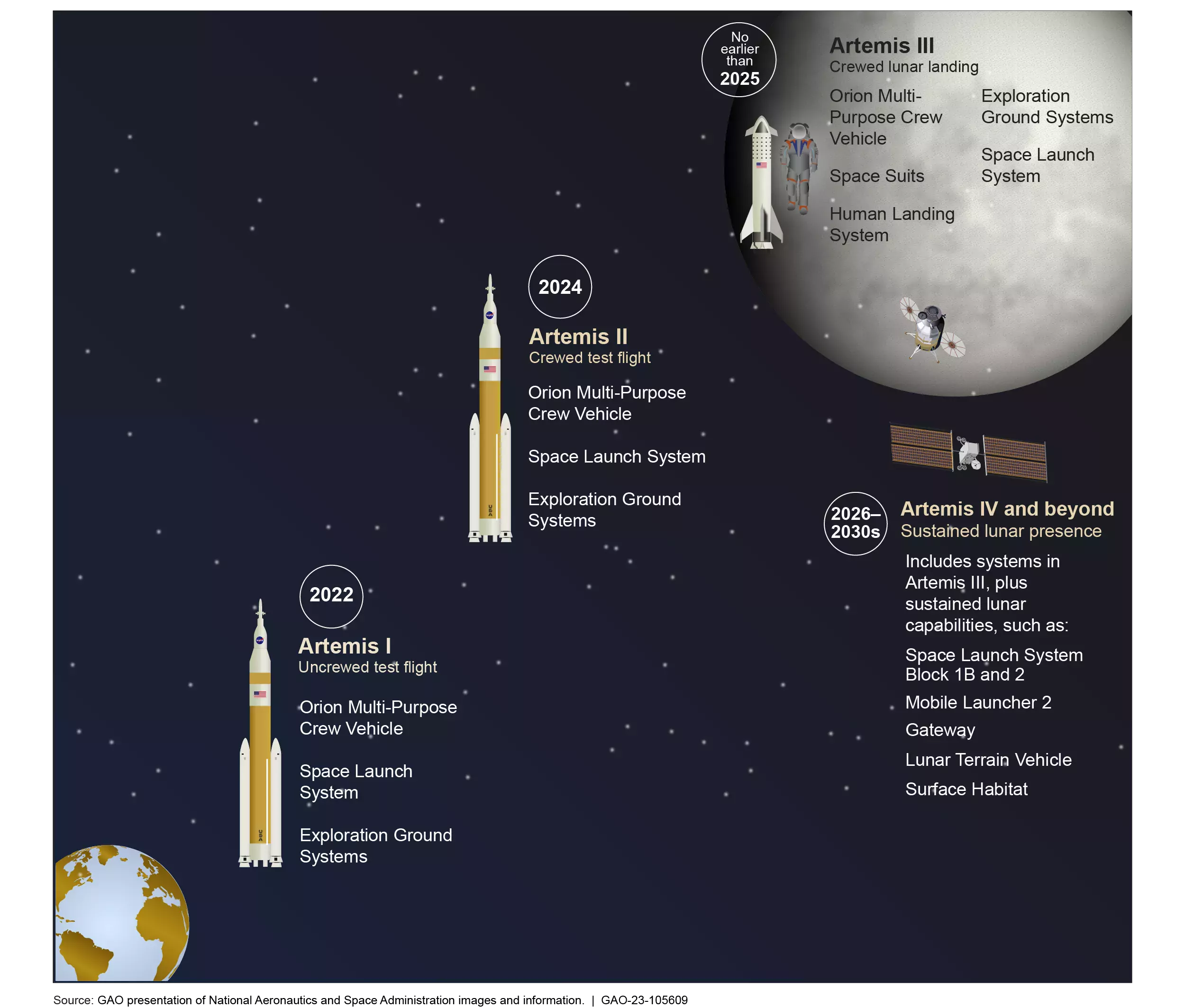As Space Activity Heats Up, What’s the Status of NASA’s Lunar Landing Efforts?
Lunar landings made headlines this summer after India’s successful uncrewed mission to the moon’s south pole. More countries and U.S. companies are also planning moonshots.
In the U.S., moon landing may seem old hat—a space race won in the 1960s. But the moon is an important steppingstone to Mars. Because of this, NASA plans to return U.S. astronauts to the surface of the moon by the end of 2025. But in a new report, we found NASA’s efforts could be delayed by several challenges.
Today’s WatchBlog post looks at our new report.
What are NASA’s Lunar plans?
The Artemis III mission is the third in a series of increasingly complex missions with the goals of maintaining U.S. leadership in space exploration, building a sustainable lunar presence over the next decade, and ultimately traveling to Mars. Artemis III will be the first time that a crew will land on the moon since the 1972 Apollo 17 mission and the first time that a crew will land at the lunar south pole. NASA believes the region holds significant promise for deep space scientific discoveries. Once on the lunar surface, U.S. astronauts will spend approximately a week conducting science exploration activities.
To accomplish the Artemis III mission, NASA is partnering with industry contractors to develop two new systems for the first crewed moon landing: SpaceX is developing the human landing system—to transport a crew to and from the lunar surface—and Axiom Space is developing modernized space suits for lunar surface operations. The agency is also relying on several systems already in development—the Orion crew capsule, the Space Launch System, and associated ground systems.
Key NASA Programs Supporting Moon Landings Under the Artemis Missions
Image

What’s the status of NASA’s lunar efforts?
Currently, NASA plans to return U.S. astronauts to the moon by the end of 2025. However, we found that while NASA and SpaceX completed several important milestones for the human landing system, a variety of factors make a lunar landing in 2025 unlikely. For example, SpaceX is facing multiple issues that limit its progress on the human landing system including an overly ambitious schedule, which will be difficult to achieve, and a large volume of remaining technical work. Similarly, Axiom is making progress on the space suits, but it also has significant work to complete before the planned 2025 launch.
While the industry contractors are working to complete development on the human landing system and space suits by December 2025, NASA is ultimately responsible for determining whether those systems are safe for flight. We found that they have plans and procedures in place to ensure that the human landing system and modernized space suits will be safe for the crew and accomplish the Artemis III mission. For example, the agency will conduct a series of reviews to determine whether the system is ready for launch.
To take the giant leap, NASA must continue to make progress
NASA is making a significant investment in achieving the lunar landing and ultimately exploring Mars. But continued progress in two areas described below will be critical to achieving the first crewed landing since 1972:
- In November, SpaceX conducted its second orbital flight test, which helped test technologies for the human landing system. This is an important step towards eventually testing the lander’s propellant transfer capabilities in space, which we found were key development tests for achieving the crewed landing in 2025.
- Axiom has built the first full space suit, which it is using to test and redesign different components. Axiom will use this suit to inform its future work on technologies in the life support system and to qualify the suit for flight.
Learn more about our work on NASA’s lunar efforts and other major projects by checking out our Quick Look from May.
- GAO’s fact-based, nonpartisan information helps Congress and federal agencies improve government. The WatchBlog lets us contextualize GAO’s work a little more for the public. Check out more of our posts at GAO.gov/blog.
GAO Contacts
Related Products

GAO's mission is to provide Congress with fact-based, nonpartisan information that can help improve federal government performance and ensure accountability for the benefit of the American people. GAO launched its WatchBlog in January, 2014, as part of its continuing effort to reach its audiences—Congress and the American people—where they are currently looking for information.
The blog format allows GAO to provide a little more context about its work than it can offer on its other social media platforms. Posts will tie GAO work to current events and the news; show how GAO’s work is affecting agencies or legislation; highlight reports, testimonies, and issue areas where GAO does work; and provide information about GAO itself, among other things.
Please send any feedback on GAO's WatchBlog to blog@gao.gov.




